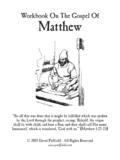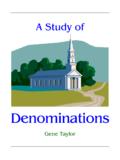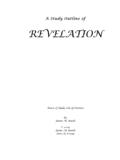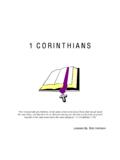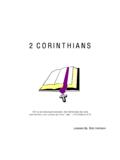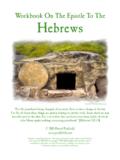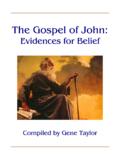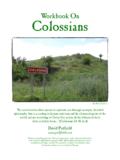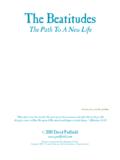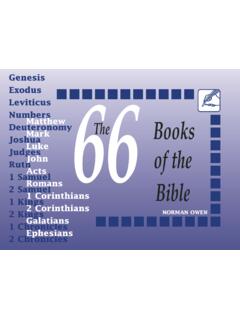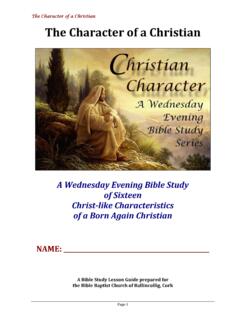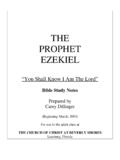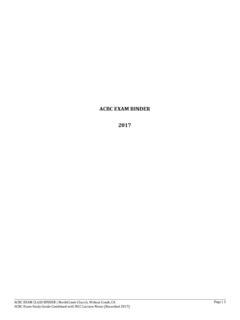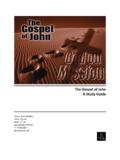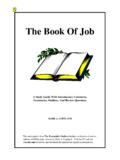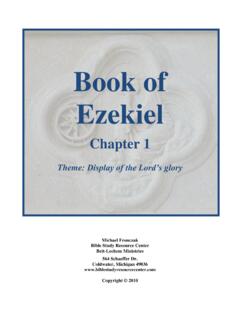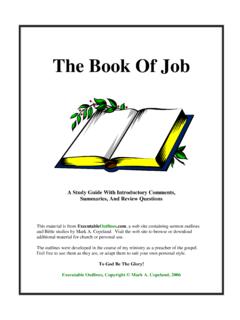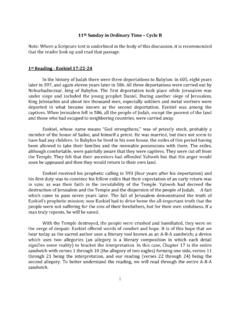Transcription of A Study of the Book of Daniel - The Church Of Christ in ...
1 A Study of the Book of Daniel . Gene Taylor Preface The Study of any of the Old Testament prophets is a worthwhile endeavor. The book of Daniel is no exception for it provides a wealth of information to those who would diligently consider it and its teachings. While the book has some things in it which may be difficult to understand, at the same time it provides many principles, lessons and insights that must not be neglected. For example, if one is going to understand the book of Revelation, he must first understand Daniel 's writings. This Study guide has been prepared to help the student, either on his own or in a classroom setting, do just that. Contained in this guide are: 1) Descriptive summaries of the Babylonian, Medo-Persian and Grecian Empires; 2) A general introduction to the book of Daniel ; 3) An outline of the book of Daniel ; 4). Summaries of every chapter of Daniel ; and 5) Questions for review and discussion on every chapter of Daniel . Commentaries which would help in your Study are The Prophecy of Daniel by Edward J.
2 Young and the volume on Daniel in the Commentary on the Old Testament by Keil and F. Delitzsch. For a short summary of Daniel , Hailey's Comments, Vol. I, by Homer Hailey will prove helpful. Enjoy your Study . Gene Taylor A Study of the Book of Daniel Gene Taylor -1- Table of Contents Preface .. 1. Table of Contents .. 2. An Introduction to Daniel .. 3. An Outline of Daniel .. 9. The Babylonian Empire .. 11. Chapter One .. 15. Chapter Two .. 16. Chapter Three .. 18. Chapter Four .. 19. Chapter Five .. 20. The Medo-Persian Empire .. 21. Chapter Six .. 25. Chapter Seven .. 26. The Grecian Empire .. 28. Chapter Eight .. 31. Chapter Nine .. 32. Chapter Ten .. 33. Chapter Eleven .. 34. Chapter Twelve .. 35. Gene Taylor, 1998. All Rights Reserved. A Study of the Book of Daniel Gene Taylor -2- An Introduction to Daniel I. The Man A. His name Daniel means God is my judge.. B. His personal life. 1. He may have descended from a noble family, perhaps he was even a prince, since normally the prominent people of a nation were taken captive (1:3, 6).
3 This would have fulfilled Isaiah's earlier prophecy. (Isaiah 39:7; 2 Kings 20:18). 2. He was carried away while a youth, about 15 years old, to Babylon during the third year of Jehoiakim (609-558 ), along with the other elite young men of Judah. 3. Given the name Belteshazzar, which meant may he (or Bel) protect the king he was instructed in the wisdom and science of the Chaldeans. a. His Study was probably in preparation for royal service. b. During that time, he was allowed by his advisor to live on vegetables and water rather than eating rich food and wine. c. His dedication made him a better student than his Babylonian counterparts. 4. He remained steadfast in his devotion to God and distinguished himself by his ability and understanding. 5. God gave him gifts in the understanding of mysteries and the interpretation of dreams. He used them to interpret two dreams for Nebuchadnezzar, king of Babylon. (chs. 2 and 4). 6. He was made ruler over the province of Babylon and chief of the governors over its wise men.
4 7. He interpreted writing for Belshazzar, probably the grandson of Nebuchadnezzar, and was further honored. (ch. 5). 8. Under Darius the Mede, who succeeded Belshazzar, he was one of three presidents of the satraps. (ch. 6). 9. His enemies made an attempt to do away with him and he was cast into a den of lions from which he was miraculously delivered. (ch. 6). a. His opponents, knowing Daniel prayed three times daily to Jehovah, had tricked Darius into issuing an edict which prohibited anyone from praying to any god or man for 30 days. b. Though Darius rued his command, he could not legally change it and, therefore, had to cast Daniel into the lions' den. c. Darius believed Jehovah would deliver Daniel . After a sleepless night, he arose early in the morning and saw that Daniel had been preserved by God. d. The enemies of Daniel , along with their wives and children, were cast into the den of lions and were immediately consumed. 10. He continued in high office all of the Babylonian period and remained in office under Cyrus, king of the Medo-Persian empire which conquered Babylon (538 ) (cf.)
5 10:1). 11. Apparently he did not return to Palestine with the Jews. Most likely he spent his last days in Babylon. 12. Daniel is one of the few well-known biblical characters about whom nothing negative is written. His life was characterized by faith, prayer, courage, consistency, and lack of compromise. This greatly beloved' man (9:23; 10:11, 19) was mentioned three times by his sixth-century contemporary Ezekiel as an example of righteousness. (Nelson's Complete Book of Bible Maps & Charts, p. 233). A Study of the Book of Daniel Gene Taylor -3- C. His prophetic ministry. 1. As a prophet, he served from 605-536 2. He was a contemporary of jeremiah (628-586 ) and Ezekiel (593-570 ), a fellow exile. (cf. Ezekiel 14:20). 3. Unlike the other prophets, such as Ezekiel who ministered directly to the people, he was primarily God's representative in the king's court of the ruling nation. 4. Daniel ministered for the full duration of the Babylonian captivity as a prophet and government official, and he continued on after Babylon was overcome by the Medes and Persians in 539 His prophetic ministry was directed to the gentile courts of Babylon and Persia, as well as to his Jewish countrymen.
6 (Nelson's, 235). D. Author of the book which bears his name. 1. That Daniel is the author of this book has been received both by the Jews and the Christian Church throughout the centuries. (William S. Deal, Baker's Pictorial Introduction to the Bible, p. 200). 2. The authorship and date of Daniel are two of the more contested issues in the field of biblical claimed to write this book (12:4), and he used the autobiographical first person from 7:2 onward. The Jewish Talmud agrees with this testimony, and Christ attributed a quote from 9:27 to Daniel the prophet' (Matt. 24:15).. (Nelson's, 233). II. The Date A. 606-536 or later. (1:1; 10:1). B. The events and prophecies of this book cover at least the full length of the 70 year exile in Babylon, from the first deportation of Hebrew captives (2 Chron. 36:5-8; Dan. 1:1-2) to the first return of the captives to their homeland (Ezra 1-2). C. The events of the book occurred during the Babylonian captivity, 605-536 Much of the book sets its own historical timetable by such references as those to Nebuchadnezzar, Belshazzar, and Darius the Mede.
7 Daniel had been in Babylon sometime before the burning of Jerusalem in 586 and the bringing of the last captives to Babylon. The book itself contains no date as to when it was written. It is clear, however, that the events making up the book occurred over a period of some time. It will be noted, though, that there is no progressive chronology in Daniel . For example, Belshazzar's tragic end is described in chapter 5, while in chapter 8 Daniel is talking about a vision which he had during the third year of Belshazzar's The reference to the instruction to Daniel to go and stand in his lot (12:13) may indicate that he was a very old man when he finished his prophetic work. It is thought that his book was written in its final form just before the close of the captivity, possibly not long before his death. (Deal, 199-200). III. The Setting A. The Judean exiles. 1. Nebuchadnezzar, returning from Jerusalem to Babylon to assume the throne following the death of his father, Nabopolassar, took with him a number of captives, including Daniel and his three friends, in 606 2.
8 A second group was exiled with King Jehoiachin, including Ezekiel, in 597 3. A third group was carried away with the destruction of Jerusalem in 586 (cf. jeremiah 52:28-30). A Study of the Book of Daniel Gene Taylor -4- 4. jeremiah had cautioned the captives to live in Babylon peaceably and prosper because after 70 years they would return to their homeland (Jer. 29:1-20). a. From the captivity of the first group (606 ) to the return of the first group of captives (536 ) was 70 years. b. From the destruction of Jerusalem and razing of the temple (586 ) to the return of the final group of captives and completion of the temple (516 ) was 70 years. B. Babylon 1. Some important historical dates. a. 625 Nabopolassar (625-605 ) rebelled against Assyria. b. 612 Babylon destroyed Nineveh, the capital of Assyria, during war. c. 609 Nebuchadnezzar, Nabopolassar's son, destroyed the Assyrian army leaving Babylon the power in the east. d. 606-605 Pharaoh-necho attacked Babylon and was defeated.
9 He returned to Egypt. e. 605 Nabopolassar died. Nebuchadnezzar (604-562 ) returned to Babylon to assume the throne. He brought the elite of Judah, including Daniel , with him. f. 597 Nebuchadnezzar returned to Judah and carried away Ezekiel and Jehoiachin and 10,000 artisans of Judah. g. 586 Nebuchadnezzar returned to Jerusalem a third time. Jerusalem fell, the temple was destroyed, and Judah was taken captive. h. 539 Babylon fell to the Medes and Persians under the reign of Cyrus the Great (538-530 ). j. 536 A group of exiled Jews returned to Jerusalem under the leadership of Zerubbabel and Joshua. k. 516 The temple was rebuilt. 2. What kind of a world was this new home of theirs? Compared to the poor little country of Palestine it was a big, rich, and prosperous country. Here the Jews found an advanced culture, big business and material splendor. Babylon, the chief city, was one of great wealth and magnificence. It was the center of a vast empire including all of Mesopotamia and the highlands beyond, as well as Syria and Palestine.
10 The city of Babylon was on the monotonous plains of the banks of the Euphrates River. Ancient writers describe it as a city surrounded by four walls, each fifteen miles in length. Twenty four streets ran north and south and the same number east and west. In this way each street terminated at a gate in the wall (100 of these) and the city was thus made up of more than six hundred square blocks. It is said that in the center of each square was a garden. The city contained many elaborate and expensive buildings such as palaces and temples. To relieve the homesickness of his wife for her native hills Nebuchadnezzar constructed, at great expense, the famous hanging gardens. In reality these were immense terraces placed on top of each other until they reached the height of the city walls. On these were planted beautiful shrubs and flowers. ( Hester, The Heart of Hebrew History, pp. 251-252). C. The visions of future world empires. 1. God gave Daniel insight into the kingdoms of the future to show the weakness of the kingdoms of men and the permanence and glory of the kingdom of God.
